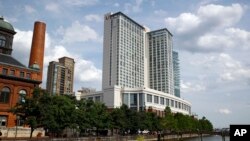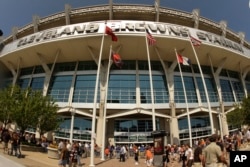In promotional brochures, a U.S. company boasted of the “stunning visual effect” its shimmering aluminum panels created in an NFL stadium, an Alaskan high school and a luxury hotel along Baltimore’s Inner Harbor that “soars 33 stories into the air.”
Those same panels — Reynobond composite material with a polyethylene core — also were used in the Grenfell Tower apartment building in London. British authorities say they’re investigating whether the panels helped spread the blaze that ripped across the building’s outer walls, killing at least 80 people.
The panels, also called cladding, accentuate a building’s appearance and improve energy efficiency. But they are not recommended for use in buildings above 40 feet because they are combustible. In the wake of last month’s fire at the 24-story, 220-foot-high tower in London, Arconic Inc. announced it would no longer make the product available for high-rise buildings.
Which buildings used it?
Determining which buildings might be wrapped in the material in the United States is difficult. City inspectors and building owners might not even know. In some cases, building records have been long discarded and neither the owners, operators, contractors nor architects involved could or would confirm whether the cladding was used.
That makes it virtually impossible to know whether the Baltimore Marriott Waterfront hotel or Cleveland Browns’ football stadium, both identified by Arconic’s brochures as wrapped in Reynobond PE, are actually clad in the same material as Grenfell Tower, which was engulfed in flames in less than five minutes.
“If the materials used on a building appear similar to a known hazard, people need to know that,” said Douglas Evans, a fire protection engineer from Las Vegas, who has been studying fires on the exterior facades of buildings for nearly 25 years. “Anybody who is inside of these buildings has a right to know.”
States, cities can set own building rules
The International Building Code adopted by the U.S. requires more stringent fire testing of materials used on the sides of buildings taller than 40 feet. However, states and cities can set their own rules, said Keith Nelson, senior project architect with Intertek, a worldwide fire testing organization.
The National Fire Protection Association conducts fire resistance tests on building materials to determine whether they comply with the international code. Robert Solomon, an engineer with the association, told the AP that the group’s records show the U.S.-made Arconic panels never underwent the tests. For that reason, he said, the group considered the products unsafe for use in buildings higher than 40 feet.
Tests conducted by the British government after the Grenfell fire found samples of cladding material used on 75 buildings failed combustibility tests.
Solomon said the use of Reynobond PE on the Baltimore Marriott and the city-owned Cleveland Browns stadium in particular should be reviewed because of their height.
Arconic height warning
On buildings that are “higher than the firefighters’ ladders,” incombustible material must be used, Arconic advises in a fire-safety pamphlet. It warns that choosing the right product is crucial “in order to avoid the fire to spread to the whole building” and that fire can spread extremely rapidly “especially when it comes to facades and roofs.”
No one has declared the U.S. buildings unsafe, nor has the U.S. government initiated any of the widespread testing of aluminum paneling that British authorities ordered after the London disaster.
Arconic declined to give further details about the buildings in the brochure, and hasn’t said how many U.S. buildings contain the product.
The company is cooperating with building owners and others involved, such as the Baltimore hotel, spokesman Steven Lipin said. The product is “certified for use in the UK and US” and the company “will continue to be here to answer any questions about its products,” Lipin said in a statement to the AP.
He did not indicate whether Arconic is contacting all the contractors, builders and others that used the material.
One option for building owners who are unsure of the product’s use would be to remove a section of paneling and have it tested at a lab, said Vickie Lovell, president of InterCode Inc., a consulting firm on building codes and standards.
Building records gone
Building records kept by cities can include construction blueprints, inspection logs and fire safety plans. But local agencies don’t require that an applicant seeking a building permit submit a list of materials or specific products. In the case of the Marriott, Baltimore’s housing department holds the building’s original plans, which don’t say what cladding was used.
The architect of record would have known what materials were used during construction. But Peter Fillat, an architect who worked on the 2001 Marriott construction, said he destroyed his records pertaining to the property six years ago because his contract requires him to keep files for only 10 years.
Construction and contracting firms that worked on the Marriott also said they no longer had those records.
For decades, the U.S. has required sprinkler systems to be installed in new high-rise buildings, as well as multiple ways for people to exit in the case of a fire. Grenfell Tower had none of those safeguards.
But fire safety experts caution that indoor sprinklers can’t stop a fire that ignites on a building’s exterior and spreads across the coating that encases it.
The danger is that “the whole outside of your building could be on fire, yet the internal sprinkler heads may never activate!” Oklahoma fire safety consultant John Valiulis wrote in a 2015 research report on the flammability of exterior walls. He pointed to high-rise fires that began on building exteriors where indoor sprinklers were completely ineffective at stopping flames from racing up the outside walls.










